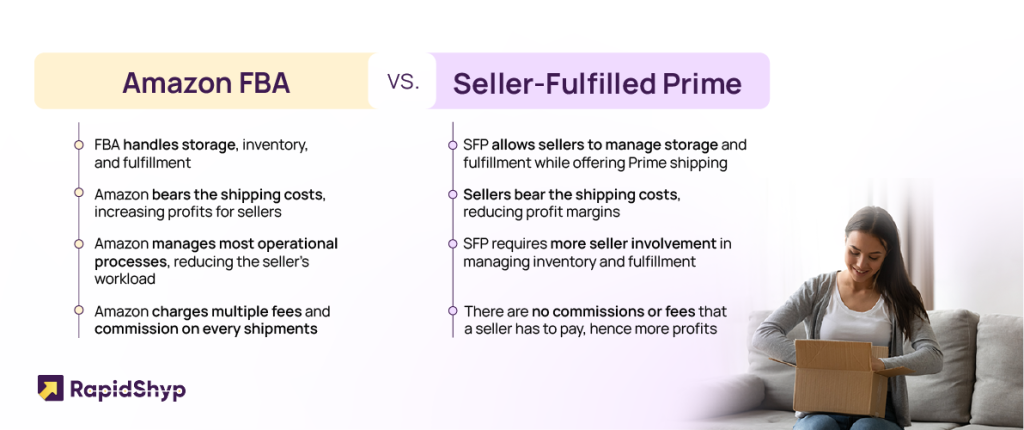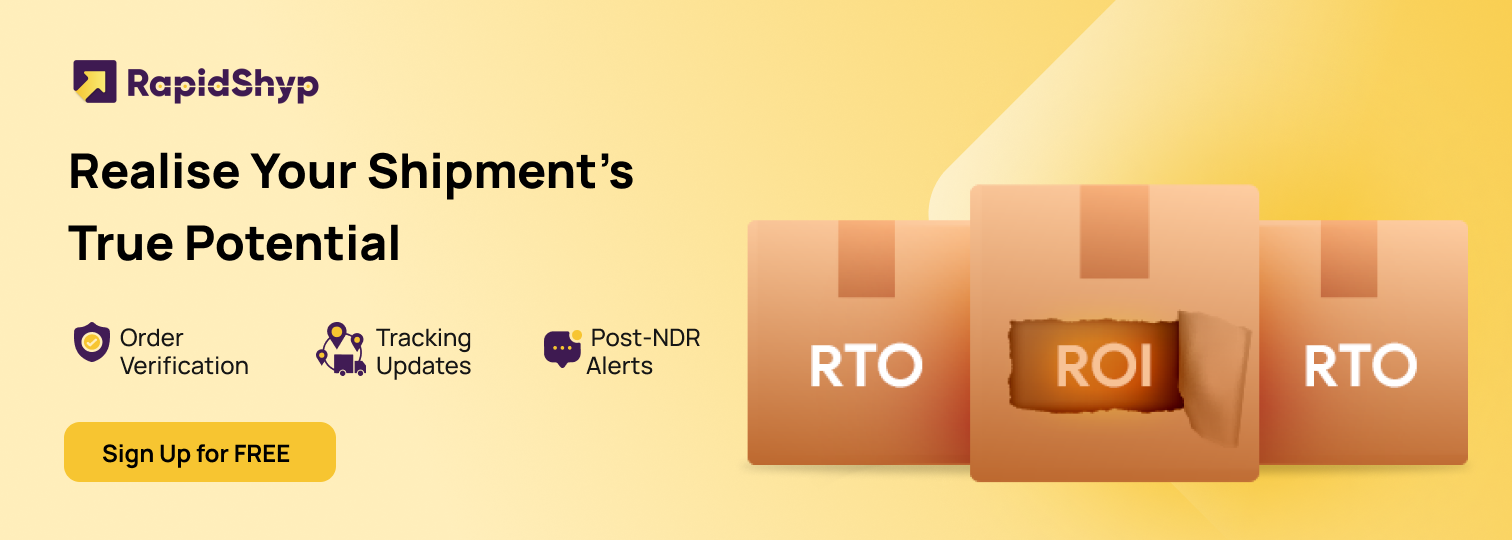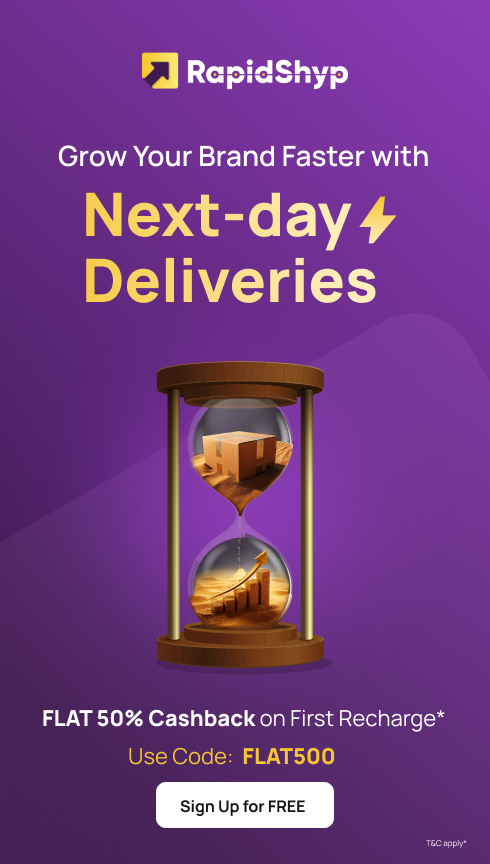Table of Contents
Fulfillment by Amazon (FBA) has emerged as a game-changer for sellers. Introduced in 2006, FBA opened up Amazon’s efficient delivery and fulfillment network to third-party sellers, allowing them to leverage the eCommerce giant’s logistics and customer service infrastructure. This blog will explore everything sellers need to know about FBA, from how it works to its benefits and challenges and how it compares with other fulfillment models.
What is Fulfilled By Amazon?
Fulfillment by Amazon is an order fulfillment model where Amazon takes on the responsibility of managing inventory, storage, picking, packing, shipping, and customer service for your orders. Sellers simply deliver their products to Amazon’s fulfillment centres, and Amazon handles the rest.
By using FBA, sellers can take advantage of Amazon’s vast marketplace, world-class fulfillment services, a variety of delivery options, and critically acclaimed customer service. Additionally, when you sign up for Amazon FBA, your products automatically become eligible for Amazon Prime, allowing for free, one-day, and even same-day delivery options. According to an Amazon survey, 86% of Prime sellers reported an increase in sales after switching to FBA.
Types of Fulfillment Models
There are various fulfillment models that eCommerce businesses can choose from, each with its advantages and drawbacks:
In-house Fulfillment
In-house fulfillment involves shipping and storing orders from a business’s premises. This model is common among smaller businesses with limited product variety and quantity. While it offers control over the entire process, it also increases overhead costs and can become challenging as order volumes grow.
Dropshipping
Dropshipping is a model where all supply chain processes, from delivery to returns, are outsourced. Sellers partner with manufacturers or third-party suppliers who handle inventory and fulfillment directly. This model minimises overhead costs and inventory risks but can result in lower margins and less control over the fulfillment process.
Third-party Fulfillment
In this model, businesses outsource various logistics processes, such as warehousing, picking, packing, shipping, and returns management, to third-party fulfillment providers. This allows businesses to scale their operations without the need for significant investments in infrastructure.
Multi-channel Fulfillment
Multi-channel fulfillment involves handling and fulfilling orders across different sales channels, such as an eCommerce website, social media platforms, and marketplaces like Amazon. This model helps businesses reach a broader audience but requires efficient inventory and order management systems.
Amazon Fulfillment (FBA)
Amazon FBA is ideal for eCommerce businesses looking to scale quickly and efficiently. With FBA, Amazon takes care of inventory storage, shipping, returns handling, and customer service, allowing sellers to focus on growing their business. FBA also makes products eligible for Prime shipping, giving sellers a competitive edge.
Amazon FBA: Pros and Cons
While FBA offers numerous benefits, it also comes with some challenges. Here’s a breakdown of the pros and cons:
Pros:
– Leverage Amazon’s Brand: Sellers can tap into Amazon’s reputation and trust to boost their own product credibility and sales.
– Speedy Operations: Amazon’s sophisticated logistics network ensures quick and efficient delivery of products.
– Free Shipping Options: FBA sellers can offer customers free shipping through Amazon Prime, which can lead to higher sales.
– Lower Operating Costs: FBA eliminates the need for sellers to manage storage, staff, and shipping logistics, reducing overhead costs.
– Multi-Channel Fulfillment (MCF): Sellers can use FBA to fulfill orders from other sales channels, not just Amazon.
– 24/7 Customer Support: Amazon provides round-the-clock customer service for FBA sellers.
Cons:
– Costly Fees: Storage, fulfillment, and removal fees can add up, especially for slow-moving or oversized products.
– Product Handling Issues: Inventory can be lost or damaged during handling. While Amazon may reimburse sellers, small losses can go unnoticed.
– Strict Product Guidelines: Amazon has specific guidelines for packaging and labelling, which, if not followed, can result in additional fees.
– Stickerless Commingling: Amazon may mix products from different sellers if they share the same manufacturer ID, which can lead to issues with product quality control.
– High Return Rates: Amazon’s lenient return policy can result in higher return rates for sellers.
How Much Does it Cost to Use Amazon FBA?
The cost of using Amazon FBA varies depending on the type of business model and products being sold. Here’s a breakdown of the primary costs:
Standard Seller Fee
Amazon charges around 15% to 18% of the product’s price as a seller fee, depending on the product category. There may also be additional hidden charges, such as partial refund deductions.
Fulfillment Fee
This fee is charged per unit and covers packing, shipping, handling, customer service, and returns. The fee varies based on the size and weight of the product.
Inventory Handling and Storage Fee
Sellers are charged a monthly storage fee based on the volume of their inventory. Additional long-term storage fees apply to products stored for over a year.
International Shipping Fee
Amazon offers global export options, enabling sellers to ship their products internationally. This service comes with additional shipping fees.
Is FBA Right for Your Business?
Choosing the right fulfillment solution depends on various factors, including the nature of your business, the types of products you sell, and your location. Amazon FBA might be the right fit for your business if:
– You want to minimise the burden of fulfillment.
– You need help scaling your business.
– You want to outsource storage, shipping, returns handling, and customer service.
– You want your products to be eligible for Prime shipping.
– You need customer service support but lack the resources to handle it in-house.
– You cannot afford to invest in warehouse space and staff.
Amazon FBA vs. Seller-Fulfilled Prime
Amazon FBA and Seller-Fulfilled Prime (SFP) are two fulfillment options for sellers looking to offer Prime shipping. Here’s how they compare:

Benefits of Choosing FBA
FBA is one of the most popular fulfillment models among Amazon sellers, with 89% of sellers using FBA in 2022. Here are some key benefits:
Focus on Business Growth
With Amazon handling logistics, sellers can focus on other aspects of their business, such as marketing and product development.
Efficient Shipping
Amazon’s logistics network ensures fast and reliable shipping, improving customer satisfaction and loyalty.
No Need for Additional Investments
FBA eliminates the need for sellers to invest in storage facilities, packaging materials, and shipping infrastructure.
Pay-Per-Order Model
FBA’s pricing structure is based on a pay-per-order model, with no additional subscription fees or setup charges.
Faster Delivery Options with Prime
FBA makes products eligible for Prime shipping, offering customers expedited delivery options like same-day, one-day, and two-day delivery.
Increased Visibility
FBA products are more likely to appear at the top of Amazon search results, leading to increased sales and exposure.
Pay on Delivery
FBA allows sellers to offer Cash on Delivery (COD) as a payment option, which can increase trust and sales, especially in regions where eCommerce is still growing.
How to Achieve Amazon-like Fulfillment Without FBA?
While Amazon FBA is a popular fulfillment model, it’s not the only option available. Sellers who do not use Amazon can achieve similar fulfillment services by partnering with third-party logistics (3PL) providers like Dispatch.
Tips to Maximize FBA Sales
To make the most of Amazon FBA, consider the following tips:
Use Analytics Tools
Leverage online tools to research popular products and categories on Amazon to identify high-demand items.
Be Smart About Product Selection
Choose products with high rankings and low competition to maximise sales and keep inventory moving.
Build Your Brand
Focus on providing excellent customer service and building a strong brand reputation to encourage repeat business and positive reviews.
Integrate FBA Offerings
Make full use of FBA’s features, such as Prime shipping, to attract more customers and increase sales.
Engage with Customers
Respond promptly to customer inquiries and feedback to build trust and ensure a positive shopping experience.
The Bottom Line
FBA offers a powerful solution for eCommerce businesses looking to scale their operations and provide customers with fast, reliable shipping. By leveraging Amazon’s vast logistics network and customer service, sellers can focus on growing their business while Amazon handles the fulfillment process. However, it’s essential to weigh the benefits and costs of FBA against other fulfillment models to determine the best fit for your business.
Calculate Your Shipping Rates

| Courier Partner | Mode | Chargeable Weight (KG) | Shipping Rates |
|---|



